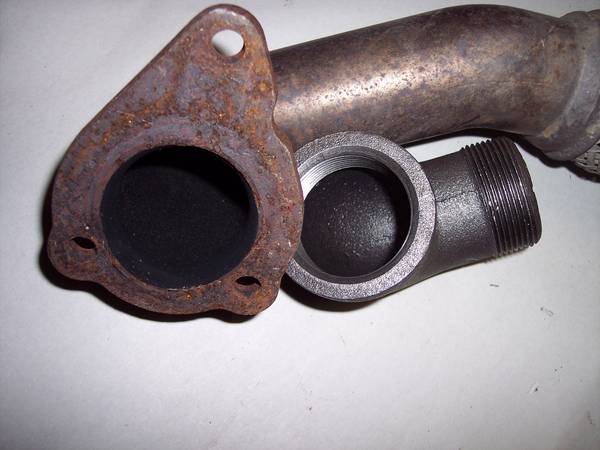AndyBees
Top Post Dawg
- Joined
- May 27, 2003
- Location
- Southeast Kentucky
- TDI
- Silver 2003 Jetta TDI, Silver 2000 Jetta TDI (sold), '84 Vanagon with '02 ALH engine
Mark, I've seen your pedal photos and seems you explained about making the change and the improvement. I like the set up!
I suppose I'll be doing the same thing. I've not done much on that end of the vehicle lately. I have removed the Vanagon Cluster, copied the Vanagon electrical schematics (made lots of notes), and looked into positioning a bracket to hold the brake and clutch switches.
Right now, I'm almost 100% focused on the rear end components! I went by the welder's place this afternoon. He has not started to work on the mounts yet (mud bog event this coming weekend and he is one of the coordinators....go figure). So, I'm still addressing minor but important things.
Here are a few photos of the Turbo and a simple "jig" to use in fabricating the down-pipe/exhaust/muffler/etc. (remember, my comments are at the top of the photo!)
In this photo, you can see the CIRCLE on the 4"X10" board which will serve as a JIG to modify/fabricate the down-pipe for the exhaust and on to the muffler.
EDIT: Although I did use these bits and pieces to fabricate an exhaust down-pipe and related exhaust components, I later custom made a SS system using the quick connections and rubber mounts. It works great. Skip over to Page 44, Post #1302 to see the custom SS down pipe!

This photo is of another angle.

Here is a close-up of the same angle as the above photo. I drilled the board to fit on the three bolts coming off the turbo outlet. This will be the reference point for cutting the down-pipe and welding in back together to be centered on the CIRCLE.

Remember this photo? Well, I've concluded that I need to abandon the 1.5 inch Street Elbow (threads on the outside) and go with a regular 1.5 inch Elbow. It will not be restrictive and welding will be no diffferent. Just imagine the down-pipe cut off, repositioned and the cast Elbow welded on to align with the CIRCLE in the JIG. Then comes the Exhaust with a regular pipe sweep elbow to go to the right side of the vehicle with a muffler! I think the angle coming off the Cast Plumbing Elbow is important so that the Exhaust/Muffler will not be too low at the back of the engine/vehicle.

I suppose I'll be doing the same thing. I've not done much on that end of the vehicle lately. I have removed the Vanagon Cluster, copied the Vanagon electrical schematics (made lots of notes), and looked into positioning a bracket to hold the brake and clutch switches.
Right now, I'm almost 100% focused on the rear end components! I went by the welder's place this afternoon. He has not started to work on the mounts yet (mud bog event this coming weekend and he is one of the coordinators....go figure). So, I'm still addressing minor but important things.
Here are a few photos of the Turbo and a simple "jig" to use in fabricating the down-pipe/exhaust/muffler/etc. (remember, my comments are at the top of the photo!)
In this photo, you can see the CIRCLE on the 4"X10" board which will serve as a JIG to modify/fabricate the down-pipe for the exhaust and on to the muffler.
EDIT: Although I did use these bits and pieces to fabricate an exhaust down-pipe and related exhaust components, I later custom made a SS system using the quick connections and rubber mounts. It works great. Skip over to Page 44, Post #1302 to see the custom SS down pipe!
This photo is of another angle.
Here is a close-up of the same angle as the above photo. I drilled the board to fit on the three bolts coming off the turbo outlet. This will be the reference point for cutting the down-pipe and welding in back together to be centered on the CIRCLE.
Remember this photo? Well, I've concluded that I need to abandon the 1.5 inch Street Elbow (threads on the outside) and go with a regular 1.5 inch Elbow. It will not be restrictive and welding will be no diffferent. Just imagine the down-pipe cut off, repositioned and the cast Elbow welded on to align with the CIRCLE in the JIG. Then comes the Exhaust with a regular pipe sweep elbow to go to the right side of the vehicle with a muffler! I think the angle coming off the Cast Plumbing Elbow is important so that the Exhaust/Muffler will not be too low at the back of the engine/vehicle.
Last edited:





